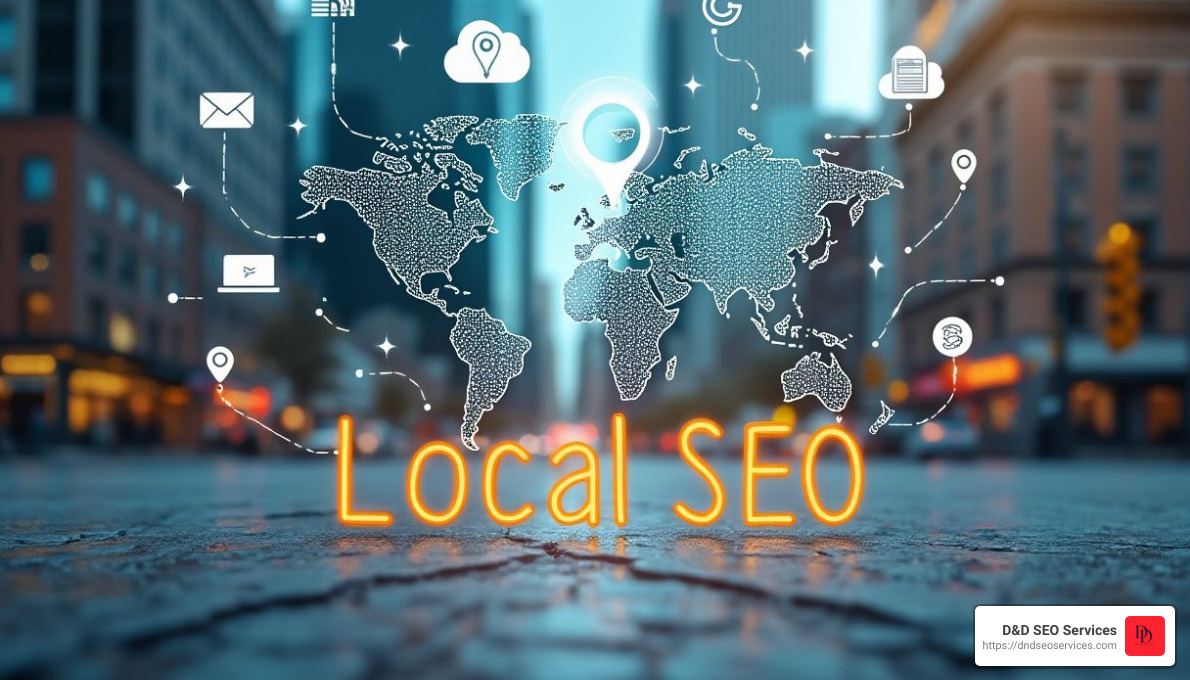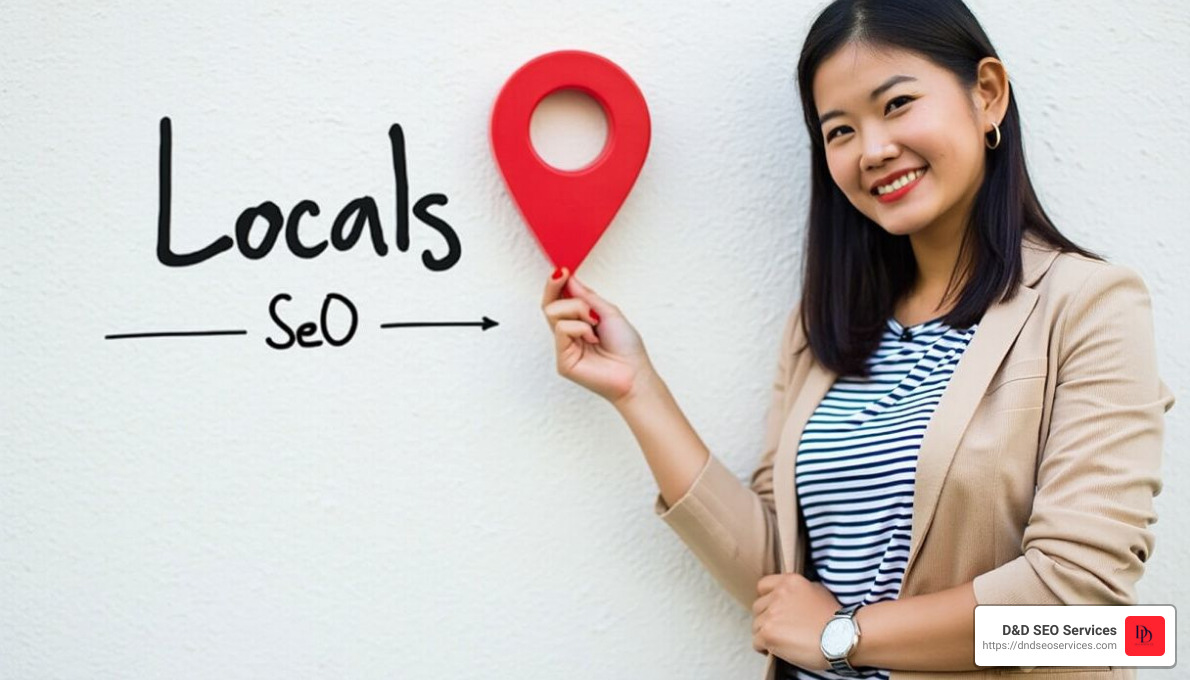Empower Your Local Business with Winning Content Marketing Strategies for Local SEO
To succeed in local SEO, engaging content is essential. If you want a quick answer on content marketing strategies for local SEO, here’s a brief outline:
- Localize your web content: Use geo-specific keywords.
- Optimize your website: Follow on-page SEO practices.
- Create local content: Write about local events, news, and guides.
- Leverage local links: Build relationships with local websites.
Local businesses thrive on visibility. Appearing in local search results is vital for attracting foot traffic and online customers. Content marketing strategies for local SEO allow your business to stand out in search engines, driving more local leads and building credibility.
Combining targeted content with local SEO can dramatically improve your search rankings. This means more people find your business when they need it most. Think of keyword-rich web pages, blog posts about local events, and strong on-page SEO practices. This is how you dominate your local market.
As the founder of D&D SEO Services, I’ve spent over a decade honing these strategies to help local businesses like yours grow. My team and I specialize in content marketing and local SEO to boost your online presence and bring in more customers.
Understanding Local SEO
Local SEO is all about making your business more visible to people searching for products or services in your area. Here’s how it works and why it’s crucial for your business.
What is Local SEO?
Local SEO (Search Engine Optimization) focuses on improving your business’s visibility in geographically-related searches. This means when someone searches for a service you offer, like “best pizza in Minneapolis,” your business appears in the search results.
Why Local SEO Matters
Local SEO is essential because nearly 46% of all Google searches are looking for local information. If your business isn’t optimized for local search, you could miss out on potential customers ready to shop in your area.
Google My Business
One of the most effective ways to improve your local SEO is by optimizing your Google My Business (GMB) listing. Here’s how:
- Claim and Verify Your Listing: Search for your business on Google Maps. If it exists, claim it; if not, create a listing. Verify your listing to prove ownership.
- Complete Your Profile: Fill out all details accurately, including your NAP (Name, Address, Phone Number), hours, website, and category. Add high-quality photos showcasing your business and products/services.
- Manage Reviews: Actively respond to reviews, both positive and negative. This shows engagement and builds trust.
- Google Posts: Share updates, events, promotions, and limited-time offers to keep your listing fresh.
NAP Citations
NAP stands for Name, Address, and Phone Number. Consistency is key here. Your NAP should be the same across all online platforms. This helps search engines verify your business information and improves your local search rankings.
Pro Tip: Avoid placing your NAP within an image since search engines can’t read text in images. Instead, include it as crawlable HTML text on your site.
Customer Reviews
Customer reviews are a powerful tool for local SEO. Positive reviews can boost your credibility and improve your rankings in local search results. Encourage satisfied customers to leave reviews and make sure to respond to them, showing that you value feedback.
Stat: Businesses with more positive reviews are more likely to rank higher in local search results.
Real-Life Example
Take the Minneapolis pizza parlor that optimized its GMB listing, ensured NAP consistency, and actively managed customer reviews. They saw a 20% increase in foot traffic within three months, proving the effectiveness of local SEO strategies.
By understanding and implementing these local SEO practices, you can make your business more visible and attract more local customers.
Next up, we’ll dive into Finding Local Keywords to further improve your local SEO efforts.
Finding Local Keywords
To succeed in local SEO, you need to find the right keywords that your potential customers are using. This involves keyword research and focusing on geo-specific keywords.
Keyword Research
Effective keyword research is the backbone of any successful SEO strategy. It helps you understand what your audience is searching for and how to tailor your content to meet their needs.
Tools like Semrush are invaluable for this. Semrush allows you to find keywords that are specific to your geographic area. For example, if you’re a family lawyer in New York, you might find that “NY family attorney” is a high-volume, low-competition keyword that you should target.
Google Keyword Planner is another excellent tool. It’s free and lets you search for keywords by location. This helps you find the most relevant terms for your business in your specific area.
Geo-Specific Keywords
Geo-specific keywords include location names in your keywords. For example, instead of just targeting “bakery,” you would target “Miami bakery.” This ensures that your business shows up in searches for people looking for services in your area.
You can also use spatial terms like “near me.” For example, “best bakery near me” is a keyword that many people use when they want to find a nearby business.
Industry-related terms are also important. If you run a gluten-free bakery, you might want to target “gluten-free cakes Miami.”
Search Volume and Competition
Understanding search volume and competition is crucial. Search volume tells you how many people are searching for a particular keyword each month. Competition indicates how difficult it will be to rank for that keyword.
Using Semrush, you can find keywords with high search volume and low competition. This balance is key to finding keywords that will drive traffic to your site without being too difficult to rank for.
Real-Life Example
Let’s say you’re a plumber in San Diego. Using Google Trends, you find that “emergency plumber San Diego” has a high search volume. You also find that the competition for this keyword is moderate. This keyword would be a great target because it is specific to your services and location.
Keyword Mapping
Once you have your keywords, it’s time to map them to specific pages on your website. Each page should target a unique primary keyword to avoid competition between your own pages.
For example:
– Home Page: “San Diego emergency plumber”
– Services Page: “San Diego plumbing services”
– Contact Page: “Contact San Diego plumber”
By finding and using the right local keywords, you can make your business more visible in local searches and attract more customers.
Next, we’ll explore Optimizing Your Website for Local SEO to ensure your site is fully optimized for these keywords.
Optimizing Your Website for Local SEO
Optimizing your website for local SEO involves several important steps. Each step helps search engines understand your content and makes it easier for local customers to find you.
On-Page SEO
On-page SEO refers to the elements on your website that you can control and optimize. These include your URL structure, title tags, meta descriptions, body content, image alt text, and internal linking.
URL Structure
A clear and descriptive URL structure helps search engines understand your page’s topic. Include your target keyword in the URL, but keep it simple.
For example:
– Good URL: www.example.com/san-diego-plumbing-services
– Bad URL: www.example.com/page123
Title Tags
Title tags are the first thing users see in search results. They should be clear, compelling, and include your target keyword.
For example:
– Good Title Tag: “San Diego Plumbing Services – Reliable & Affordable”
– Bad Title Tag: “Home”
Meta Descriptions
Meta descriptions are short summaries of your page content. They appear under the title in search results and should include your target keyword and a call to action.
For example:
– Good Meta Description: “Need a reliable plumber in San Diego? Contact us for fast and affordable plumbing services. Call today!”
– Bad Meta Description: “Welcome to our website.”
Body Content
Body content is the main text on your web pages. It should be informative, engaging, and include your target keywords naturally.
Tips for body content:
– Include your main keyword in the first 100 words.
– Use subheadings (H2, H3) to break up text.
– Write for humans, not just search engines.
Image Alt Text
Image alt text helps search engines understand what an image is about. It also improves accessibility for visually impaired users.
Tips for image alt text:
– Describe the image clearly.
– Include your target keyword if relevant.
Internal Linking
Internal linking connects different pages on your website. It helps users steer and tells search engines about the structure of your site.
Tips for internal linking:
– Link to related pages using descriptive anchor text.
– Avoid using generic terms like “click here.”
By focusing on these on-page SEO elements, you can improve your website’s local search visibility and attract more local customers.
Next, we’ll explore Creating Localized Content to help you engage with your local audience effectively.
Creating Localized Content
Creating localized content is crucial for connecting with your local audience and boosting your local SEO. Let’s dive into how you can do this effectively.
Local Content
Start by understanding your local audience. Research what interests them, their pain points, and what they are searching for. Tools like Semrush can help you find geo-specific keywords.
Blog Posts
Blog posts are a great way to engage your local audience. Write about local events, trends, and business updates. For example, a Canada-based IT company expanded its reach by posting about local automotive events and IT trends.
Ideas for local blog posts:
– Local Events: Write about upcoming events like festivals, sports games, or concerts.
– Local Trends: Discuss trends relevant to your industry in your area.
– Business Updates: Share news about your business, such as new services or community involvement.
Local Guides
Creating local guides can attract tourists and locals alike. For instance, if you run a restaurant, create a guide about “Best Places to Eat in [Your City].” This not only helps your SEO but also establishes you as an authority in your area.
Examples of local guides:
– Tourist Guides: “Top 10 Things to Do in [City]”
– How-To Guides: “How to Spend a Weekend in [City]”
Local Business Updates
Keep your audience informed with updates about your business. Whether it’s a new product launch or a change in business hours, these updates can keep your audience engaged and informed.
Types of updates to share:
– New Services: Announce any new services or products.
– Community Involvement: Share your participation in local events or charities.
Local Events and Activities
Writing about local events and activities can drive local traffic to your site. For instance, if there’s a big conference coming to town, write a blog post offering tips related to your service.
Examples of local events to cover:
– Sporting Events: Write about local sports games.
– Networking Events: Share information about business networking opportunities.
– Seasonal Events: Discuss upcoming seasonal activities like fairs or holiday celebrations.
By focusing on creating localized content, you can effectively engage with your local audience and improve your local SEO.
Next, we’ll explore how to leverage Google My Business to further improve your local SEO strategy.
Leveraging Google My Business
Google My Business (GMB) is a powerful tool for enhancing your local SEO. It helps your business appear in local search results and provides essential information to potential customers.
Setting Up Your Profile
First, create and verify your GMB profile. Make sure every field is filled out accurately. This includes your business name, address, and phone number. Consistency is key. Ensure that your NAP (Name, Address, Phone Number) information matches across all online platforms.
Essential Information to Include
- Business Name: Use your official business name. Avoid adding extra keywords or location names here.
- Address: Enter your complete address. If you have multiple locations, create separate listings for each.
- Phone Number: Use a local phone number. This helps Google verify your business location.
- Business Hours: Keep your business hours up-to-date. Include special hours for holidays or events.
- Directions: Make sure your location is easy to find on Google Maps. An embedded map can help customers locate you quickly.
- Contact Information: Provide multiple ways for customers to contact you, such as email, phone, and website.
Additional Features to Improve Your Profile
- Photos: Upload high-quality photos of your business, products, and services. Photos can increase engagement and attract more customers.
- Business Description: Write a compelling description. Highlight what makes your business unique and include local keywords naturally.
- Posts: Use GMB posts to share updates, offers, and events. These posts appear in your GMB listing and can drive more traffic to your site.
- Reviews: Encourage customers to leave reviews. Respond to all reviews, both positive and negative. This shows that you value customer feedback.
Example of a Complete GMB Profile
Imagine a bakery called “Sweet Treats” in Boston. Here’s what their GMB profile might include:
- Business Name: Sweet Treats Bakery
- Address: 123 Main St, Boston, MA 02101
- Phone Number: (617) 555-1234
- Business Hours: Mon-Fri 7 AM – 7 PM, Sat-Sun 8 AM – 5 PM
- Directions: Embedded map showing the exact location
- Contact Information: Email: [email protected], Phone: (617) 555-1234
- Photos: Pictures of the bakery, cakes, and staff
- Business Description: “Sweet Treats Bakery offers a variety of delicious cakes, pastries, and bread made fresh daily. Located in the heart of Boston, we pride ourselves on using local ingredients and traditional recipes.”
- Posts: Updates about new products, special offers, and holiday hours
- Reviews: Engaging with customer feedback and thanking them for their support
By leveraging Google My Business, you can improve your local SEO and make it easier for customers to find and choose your business. Next, we’ll discuss how to build local backlinks to further boost your local SEO efforts.
Building Local Backlinks
Building local backlinks is crucial for boosting your local SEO. These are links from other local websites back to yours. They signal to search engines that your business is trustworthy and relevant in your area. Here are some effective strategies to build local backlinks:
Guest Posts
Guest posting is a great way to earn backlinks while sharing your expertise. Reach out to local blogs and news sites and offer to write articles on topics relevant to your industry. For example, if you own a bakery, you could write about “The Best Pastries for a Boston Winter.” This not only provides value to the readers but also includes a backlink to your site.
Local Publishers
Local publishers, like community blogs and news websites, are excellent platforms for guest posts. For instance, if you’re a business in Seattle, getting featured on WestSeattleBlog.com or VisitSeattle.org can drive valuable traffic to your website. These sites often publish content from local businesses, giving you a chance to reach a broader local audience.
Local Businesses
Partnering with other local businesses can also help you earn backlinks. For example, a local gym could collaborate with a nearby health food store. They could offer joint promotions and feature each other on their websites. This kind of partnership not only drives traffic but also builds a sense of community.
Outreach
Conducting outreach to local businesses and organizations is another effective strategy. Send personalized emails introducing yourself and your business. Explain how your content or expertise could benefit their audience. Be polite, concise, and specific. Follow up with a friendly reminder if you don’t hear back initially.
Local Traffic
Getting backlinks from local sources can significantly boost your local traffic. For example, sponsoring a local event or charity can get your business name featured on the event’s website. This not only drives traffic but also builds trust within the community. An HVAC service sponsoring a local fair could get a backlink from the event’s homepage, enhancing its local search rankings.
By focusing on these strategies, you can build a strong portfolio of local backlinks that improve your local SEO. This not only improves your search engine rankings but also establishes your business as a trusted community member.
Next, we’ll discuss how to engage with local audiences on social media to further boost your local SEO efforts.
Engaging with Local Audiences on Social Media
Social media is a powerful tool for connecting with your local community. Here are some effective content marketing strategies for local SEO that can help you engage with local audiences on platforms like Facebook and LinkedIn.
Join and Participate in Local Facebook Groups
Local Facebook Groups are gold mines for connecting with your community. These groups often focus on specific neighborhoods, interests, or local issues.
Action Steps:
– Join relevant local groups.
– Share your content, such as blog posts about local events or guides.
– Engage by commenting on posts, answering questions, and sharing valuable insights.
For example, a local bakery could join a neighborhood group and share updates about new products or special offers. This not only increases visibility but also builds a loyal local following.
Use LinkedIn Groups for Professional Networking
LinkedIn Groups are ideal for B2B businesses looking to connect with local professionals.
Action Steps:
– Find and join local business or industry-specific groups.
– Share articles, case studies, and news related to your business.
– Engage in discussions and offer professional advice.
A digital marketing agency in Denver, for instance, could join a local business group and share tips on improving online visibility. This positions them as a local expert and attracts potential clients.
Leverage Local Event Pages
Local event pages on social media platforms like Facebook are great for promoting your business and engaging with the community.
Action Steps:
– Follow local event pages and keep an eye on upcoming events.
– Share your content related to these events.
– Engage with attendees by commenting on posts and sharing your experiences.
For instance, if there’s a big local festival coming up, a local restaurant could share a blog post about the best food to try at the festival. This not only drives traffic to their website but also engages festival-goers.
Collaborate with Local Businesses
Partnering with other local businesses can amplify your reach and build strong community ties.
Action Steps:
– Identify non-competing local businesses that share your target audience.
– Collaborate on social media campaigns or events.
– Cross-promote each other’s content.
A gym and a local smoothie shop could team up for a “Healthy Living” campaign, sharing each other’s posts and offering joint promotions. This not only boosts engagement but also introduces both businesses to new audiences.
Share Location-Specific Content
Creating and sharing content that highlights local culture, events, and issues can significantly boost your local SEO.
Action Steps:
– Post about local events, trends, and news.
– Share stories and testimonials from local customers.
– Use location-specific hashtags and geotags.
For example, a real estate agent could post about the best neighborhoods to live in and share client testimonials. This not only provides valuable information but also builds trust within the community.
By engaging with local audiences on social media, you can significantly improve your local SEO efforts. This not only drives more traffic to your website but also strengthens your presence in the community.
Next, we’ll explore common local SEO mistakes to avoid to ensure your strategy is effective and efficient.
Avoiding Common Local SEO Mistakes
When it comes to local SEO, even small mistakes can have a big impact. Let’s look at some common pitfalls and how to avoid them.
Local Keyword Targets
Mistake: Not using local keywords in your content.
Solution: Integrate local keywords naturally into your website and blog posts. Tools like Google’s Keyword Planner and SEMrush’s Keyword Magic Tool can help identify terms that your local audience is searching for. For instance, instead of just “pizza delivery,” use “pizza delivery in Minneapolis.”
Customer Reviews
Mistake: Neglecting to gather and manage customer reviews.
Solution: Encourage satisfied customers to leave positive reviews on your Google Business Profile and other review sites like Yelp. Respond to reviews—both good and bad—to show that you value customer feedback. According to a local business review survey, reviews significantly impact consumer behavior and your local SEO ranking.
NAP Consistency
Mistake: Inconsistent Name, Address, Phone Number (NAP) information across different platforms.
Solution: Ensure your NAP information is consistent everywhere—on your website, social media profiles, and directory listings. Inconsistent NAP information can confuse search engines and lower your ranking.
Directory Listings
Mistake: Not claiming or updating directory listings.
Solution: Claim and update your listings on relevant directories like Yelp, Yellow Pages, and your local Chamber of Commerce. Use tools like Whitespark or BrightLocal to find and manage these listings. Accurate and consistent listings help improve your local search visibility.
Google Business Profile
Mistake: Not optimizing or regularly updating your Google Business Profile.
Solution: Optimize your profile by filling out all the details—business name, address, phone number, business hours, and directions. Regularly update it with new photos and gather fresh reviews. According to Forbes, keeping your profile updated increases your authenticity and helps you rank higher in local searches.
By avoiding these common mistakes, you can ensure your content marketing strategies for local SEO are effective and efficient. This will help you attract more local customers and grow your business.
Next, we’ll address some frequently asked questions about content marketing strategies for local SEO.
Frequently Asked Questions about Content Marketing Strategies for Local SEO
What is the best strategy for local SEO?
The best strategy for local SEO involves several key components:
- Local Keywords: Use geo-specific keywords that your potential customers are searching for. Tools like Google Keyword Planner and Semrush can help you identify these keywords.
- Website Optimization: Ensure your website is optimized for local search. This includes on-page SEO elements like title tags, meta descriptions, and body content that mention your location naturally.
- Google Business Profile: Claim and verify your Google Business Profile. Keep it updated with accurate NAP (Name, Address, Phone number) information, business hours, and high-quality images.
- NAP Citations: Consistency is key. Your NAP information should be the same across all online directories and platforms.
- Customer Reviews: Encourage satisfied customers to leave positive reviews. Respond to all reviews to show engagement.
- Content: Create localized content such as blog posts about local events, guides, and news. This helps you connect with your local audience.
- Backlinks: Build local backlinks by collaborating with local businesses and guest posting on local publishers’ websites.
- Google Ads: Use Google Ads to target local customers. This can be particularly effective for immediate visibility.
What is SEO content marketing strategy?
An SEO content marketing strategy focuses on creating high-quality content that ranks well on search engines. This involves:
- SEO Content: Content should be optimized for search engines using relevant keywords. It should answer the questions your audience is asking.
- High-Quality Content: Google prioritizes content that offers expert insights and genuine advice. Make sure your content is informative and valuable.
- Search Engines: Understand how search engines work and what they prioritize. Google’s algorithm favors content that is relevant, authoritative, and trustworthy.
- Organic Traffic: The goal is to drive organic traffic to your site. This means people find your website through search engine results rather than paid ads.
What are the top 5 SEO strategies?
- Fast Website: Ensure your website loads quickly. Slow websites can hurt your rankings and user experience.
- Mobile-Friendly: With more people using mobile devices to search, your website must be mobile-friendly. Google favors mobile-optimized sites.
- Long-Tail Keywords: These are specific phrases that potential customers are likely to search for. They often have less competition and higher conversion rates.
- Local Listings: Get your business listed on local directories and ensure your NAP information is consistent.
- Helpful Content: Create content that is genuinely helpful to your audience. This increases engagement and shares, boosting your SEO.
- Re-Optimization: Regularly update and optimize your existing content. This keeps it relevant and helps maintain your rankings.
- ROI Measurement: Use tools like Google Analytics to measure the success of your SEO efforts. Track metrics like organic traffic, conversion rates, and search rankings.
By implementing these strategies, you can improve your local SEO and attract more customers.
Next, let’s move on to the conclusion of our guide on content marketing strategies for local SEO.
Conclusion
At D&D SEO Services, we understand that every business is unique, and so are its SEO needs. Our personalized strategies are designed to fit your specific goals and challenges, ensuring you get the best possible results.
Local SEO is more crucial than ever. According to recent data, 46% of all internet searches have local intent. This means a strong local SEO strategy can significantly boost your online visibility and attract more customers from your community. Our team specializes in optimizing your online presence to make sure you stand out in local search results.
We use AI-driven solutions to stay ahead of the competition. These advanced tools help us analyze your website’s performance, identify areas for improvement, and implement effective strategies custom to your business. This data-driven approach ensures that your local SEO efforts are not only efficient but also highly effective.
Our ultimate goal is to drive business growth for our clients. We focus on both short-term wins and long-term strategies to ensure sustained success. Whether it’s improving your website’s performance, optimizing your Google Business Profile, or creating engaging local content, we cover all aspects of local SEO to help you achieve your business objectives.
Ready to open up the power of local SEO for your business? Contact us today to get started on your journey to online success!
By integrating these strategies, we help you create a stronger digital narrative that resonates with your audience, fostering growth and sustained customer relationships.








